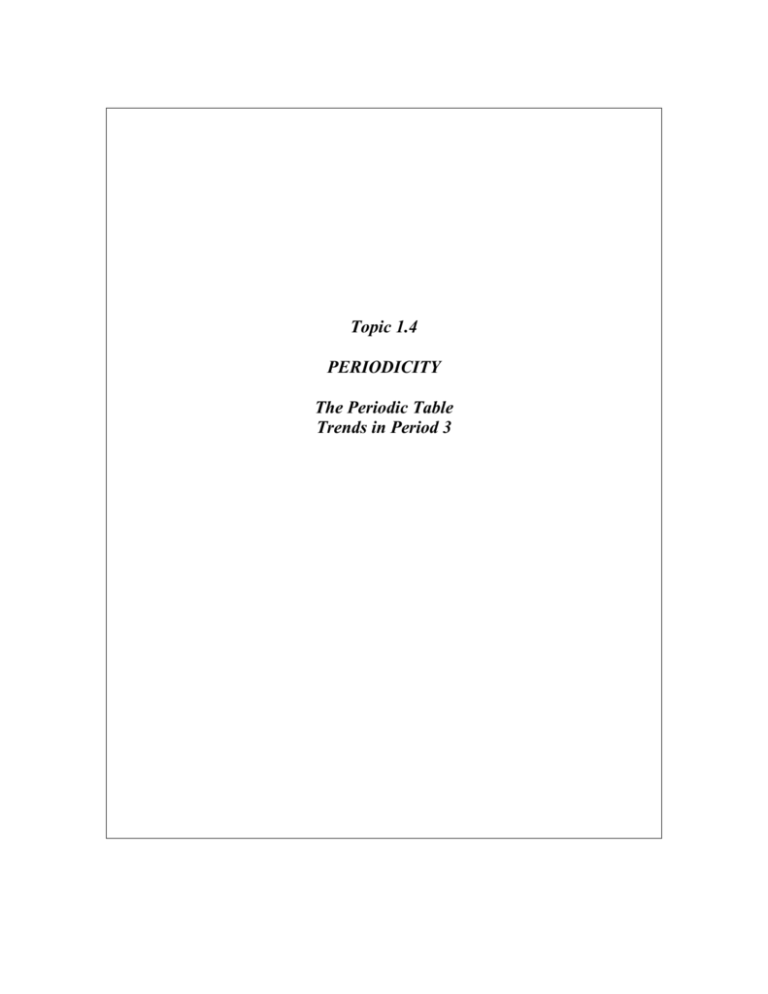here - A-level chemistry
advertisement

Topic 1.4 PERIODICITY The Periodic Table Trends in Period 3 THE PERIODIC TABLE The periodic table is a list of all known elements arranged in order of increasing atomic number, from 1 to 106. In addition to this, the elements are arranged in such a way that atoms with the same number of shells are placed together, and atoms with similar electronic configurations in the outer shell are also placed together. This is achieved as follows: The elements are arranged in rows and columns. Elements with one shell are placed in the first row (ie H and He), Elements with two shells are placed in the second row (Li to Ne) and so on. A row of elements thus arranged is called a period. In addition, the elements are aligned vertically (in columns) with other elements in different rows, if they share a similar outer-shell electronic configuration. For example, elements with outer-shell configuration ns1 are all placed in the same column ( Li, Na, K, Rb, Cs, Fr). A column of elements thus arranged is called a group. According to these principles, the periodic table can be constructed as follows: I II III IV V VI VII H Li Na K Rb Cs Fr Be Mg Ca Sr Ba Ra Sc Y La Ac Ce - Lu Th - Lw 0 He Ti Zr Hf V Nb Ta Cr Mo W Mn Tc Re Fe Ru Os Co Rh Ir Ni Pd Pt Cu Ag Au Zn Cd Hg B Al Ga In Tl C Si Ge Sn Pb N P As Sb Bi O S Se Te Po F Cl Br I At Ne Ar Kr Xe Rn Since the electronic configurations of H and He are unusual, they do not fit comfortably into any group. They are thus allocated a group based on similarities in physical and chemical properties with other members of the group. He is placed in group 0 on this basis, but hydrogen does not behave like any other element and so is placed in a group of its own. The elements Ce - Lu and Th - Lw belong in the periodic table as shown above. However if they are placed there periods 6 and 7 do not fit onto a page of A4, so they are placed below the other elements in most tables. All elements belong to one of four main blocks: the s-block, the p-block, the d-block and the f-block. The s-block elements are all those with only s electrons in the outer shell. The p-block elements are all those with at least one p-electron in the outer shell. The d-block elements are all those with at least one d-electron and at least one selectron but no f or p electrons in the outer shell. The f-block elements are all those with at least one f-electron and at least one s-electron but no d or p electrons in the outer shell. I II III IV V VI VII 0 H Li Na K Rb Cs Fr Be Mg Ca Sr Ba Ra Sc Y La Ac Ce - Lu Th - Lw He Ti Zr Hf V Nb Ta Cr Mo W Mn Tc Re Fe Ru Os Co Rh Ir Ni Pd Pt Cu Ag Au Zn Cd Hg B Al Ga In Tl C Si Ge Sn Pb N P As Sb Bi O S Se Te Po F Cl Br I At Elements coloured green are in the s-block Elements coloured blue are in the p-block Elements coloured red are in the d-block Elements coloured black are in the f-block The physical and chemical properties of elements in the Periodic Table show clear patterns related to the position of each element in the Periodic Table. Elements in the same group show similar properties, and properties change gradually on crossing a Period. As atomic number increases, the properties of the elements show trends which repeat themselves in each Period of the Periodic Table. These trends are known as Periodic Trends and the study of these trends in known as Periodicity. Ne Ar Kr Xe Rn TRENDS IN PERIOD 3 1. Properties of individual atoms a) atomic size On moving across Period 3 from left to right, the nuclear charge increases but the shielding stays the same. The attraction of the outer electrons to the nucleus thus increases and the outer electrons are pulled in closer. The size of the atoms just decreases on crossing a period – i.e. sodium is the largest atom in Period 3 and neon is the smallest. Size of atoms of Period 3 elements 0.25 0.2 Na 0.15 nm Mg Al Si 0.1 P S Cl Ar 0.05 0 b) ionization energies Ionisation energy generally increases across period 3 but decreases between groups II and III and also between groups V and VI. Ionisation energy increases across period 3 because the nuclear charge increases but the shielding remains the same, making the electrons harder to remove. Ionisation energy decreases from group II to group III because the outer electron in Al is in a 3p orbital, but the outer electron in Mg is in a 3s orbital. The 3p orbital is better shielded from its nucleus making it easier to remove. Ionisation energy decreases from group V to group VI because the outermost 3p electron in S is paired, so there is repulsion in the orbital and the electron is easier to remove. The outermost 3p electron in P is unpaired, so experiences less repulsion and is harder to remove. Ist ionisation energies of Period 3 elements 1800 Ionisation energy (kJ/mol) 1600 Ar 1400 Cl 1200 P 1000 800 600 S Si Mg Al Na 400 200 0 c) electronegativity Electronegativity increases across period 3. As the nuclear charge increases but the shielding remains the same, the electrons are attracted more strongly to the atom, so that atom will have a larger share of the electrons in a covalent bond. 2. Structure and Bonding The structure and bonding of the elements in period 3 of the Periodic Table varies widely. There is a gradual decrease in metallic character in crossing a period. On crossing a period the ionisation energies increase so it becomes more difficult to remove electrons and form metallic structures. Thus covalent bonding becomes more common on crossing a period from left to right. The noble gases form neither metallic nor covalent bonds with each other. The ionisation energies are very high so metallic bonding is not possible. There are no unpaired electrons so covalent bonding is not possible. Thus they form no bonds and exist as free gaseous atoms. The trends in intramolecular bond type can be seen in the following table: Na metallic Mg metallic Al metallic Si covalent P covalent S covalent Cl covalent Ar - The variation on bond type causes a number of differences in the structures of the Period 3 elements which in turn causes significant differences in physical properties. a) Sodium, Magnesium and Aluminium Sodium, Magnesium and Aluminium are metals. They consist of an infinite lattice of cations held together by a sea of delocalised electrons. There is a fairly strong attraction between the cations and the delocalised electrons and as a result metals tend to have fairly high melting points and boiling points. The melting points increase with increasing charge and decreasing size and thus increase across a period. Element Mpt/oC Bpt/oC Sodium 98 883 Magnesium 669 1107 Aluminium 680 2467 The delocalised electrons in the metal structure are free to move throughout the metal lattice and can thus behave as charge carriers. When a potential difference is applied, the electrons can move towards the positive electrode. Thus metals are good conductors of electricity. Electrical conductivity increases from sodium to aluminium as the number of delocalized electrons per atom increases. Aluminium has three electrons per atom in the sea, magnesium two per atom and sodium only one per atom. b) Silicon Silicon is a giant covalent macromolecule. Silicon atoms form infinite lattices in which all the atoms are held together by strong covalent bonds. Since the structure cannot be broken up without breaking these strong covalent bonds, it follows that silicon has a very high melting and boiling point. The structure of silicon is tetrahedral, identical to diamond: Structure SILICON: Mpt/oC Bpt/oC 1406 2355 Silicon does not conduct electricity well as it has no free electrons and no free ions. c) Phosphorus, sulphur, chlorine and argon Phosphorus, sulphur, chlorine and argon form simple molecular structures.There are strong, covalent bonds within the molecule but the different molecules are only held together by weak Van der Waal's forces. Separating these molecules thus requires little energy and the melting and boiling points of these elements are relatively low. The larger the molecule, the greater the magnitude of the temporary and induced dipoles and the higher the melting and boiling points. Element Structure Phosphorus P Sulphur P S S P P P P P Mpt/oC Bpt/oC Formula P P P P P S S P P S S S S S S Chlorine S S S S S S S S S S S S S S Cl Cl Cl Cl Cl Cl Cl Cl Cl Cl P Ar Ar Ar Ar P 44 280 P4 (or P) Argon 119 445 S8 (or S) -101 -35 Cl2 Ar Ar -189 -186 Ar Sulphur has the highest melting point as it exists as S8 molecules. These molecules are quite large, so the number of electrons in the molecule is high and the Van der Waal’s forces are quite strong. Phosphorus exists as P4 molecules, which have fewer electrons in them and so have weaker Van der Waal’s forces. So phosphorus has a lower melting point than sulphur. Chlorine exists as molecules, which have even fewer electrons in them so the Van der Waal’s forces are lower and chlorine has a lower melting point than sulphur and phosphorus. Argon has the lowest melting and boiling point of all, as it exists as single Ar atoms which have even less electrons and so only form very weak Van der Waal’s forces. These elements do not conduct electricity well as they have no free electrons and no free ions. 3. Summary of properties of period 3 elements Atomic size – decreases across the period First ionization energy – increases across the period except between Mg and Al and between P and S Electronegativity – increases across the period Melting and boiling point – increases from Na to Al – increases from Al to Si – decreases from Si to P – increases from P to S – decreases from S to Ar Electrical conductivity – increases from Na to Al – is zero from Si to Ar Element: Sodium Magnesium Aluminium Silicon Bonding: Metallic Metallic metallic covalent Phosphorus (white) Covalent Sulphur covalent Structure: + + Na Na e e e + + Na Na e Type: Melting point/oC: Boiling point/oC: First IE/ kJmol-1: E-negativity Electrical conductivity (x10-8Ω-1m-1) 2+ 3+ 2+ Mg Mg e e e e e e e e 2+ 2+ Mg Mg e e e Metallic Metallic Metallic 98 669 883 P P P P P P P S P P P S S P P S S S S S S S Al e e e ee 3+ e 3+ e Al Al ee Al P P 3+ S S S S S S S S S S S P P 680 Giant covalent 1410 Simple molecular 44 Simple molecular 119 1107 2467 2355 280 445 496 738 578 789 1012 1000 0.9 0.21 1.2 0.26 1.5 0.41 1.8 0 2.1 0 2.5 0 NB You do not need to know the exact figures, just know the trends and be able to explain them.






